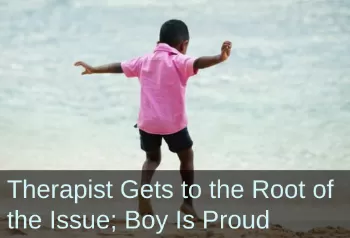Primitive Reflex Integration Case Studies
Skeptical Therapist Sees Surprising Progress in Releasing Fears and Achieving Goals
Neurodevelopmental movements provide relief from anxiety
This young boy became very afraid whenever his face was covered, such as when getting dressed. He was anxious in enclosed spaces, and exhibited general emotional dysregulation. See how his therapist used neurodevelopmental movements—including Fear Paralysis Reflex integration—from the Brain and Sensory Foundations course to completely transform these challenges.
Submitted by Erin Carlson Taylor, MS, OTR/L

| Before | After |
|---|---|
| Inappropriately fearful when enclosed or face was covered; worked toward the goal of being able to crawl through a cloth tunnel for a year or more with no sustained progress | Can now easily crawl through the tunnel multiple times without any resistance or avoidance |
| Frequent emotional dysregulation | Less overall emotional dysregulation |
DC is a 6 ½ year old boy who I had been seeing in OT for a couple years 1X/week. He had a combination of sensory challenges and learning challenges including handwriting, letter recognition, and reading struggles. His mother’s primary concerns initially were related to diet and picky eating and emotional regulation. He had made steady progress over the years with traditional OT, but one particular concern that mom reported was that he became inappropriately fearful for his age when his face was covered. This brought about challenges with taking on/off sweatshirts and especially tight swim shirts. In therapy this behavior was noticed when suggesting he get into a lycra swing that enclosed his body, or being covered under large bean bags. He was particularly fearful of crawling through a long cloth tunnel. He wanted to be able to crawl through this tunnel and we literally worked toward this goal on and off for a year or more with no sustained progress.
Once introduced to the activities in the Brain and Sensory Foundations First Level course, I started incorporating all of the rhythmic movements and taught mom how to do them as well. Her carryover was not consistent. He tolerated the passive movements well, but was unable to sustain rhythmic movements actively, demonstrating brain stem and cerebellum immaturity. Early in the introduction of rhythmic movements and reflex integration activities, I noted that DC did not like the Fear Paralysis Tapping at all.
Several weeks after starting the rhythmic movements, we did a 5-Step Balance [from the Brain and Sensory Foundations First Level course] with the goal of crawling through the cloth tunnel. DC was very anxious about the idea of it. We used Moro reflex integration during the 5-Step Balance. After acting out the goal the 2nd time, DC stated, “I think I might be able to do it.” He was able to crawl through the tunnel with a flashlight the next week and was very proud of himself. Although I was amazed that the 5-step balance worked after all the grading of the activity that I had done in the past, there was still a level of anxiety about the tunnel that didn’t go away and would come back stronger when he missed a few weeks of therapy.
We did the 5-Step Balance with the same goal a few months later but used the Fear Paralysis Tapping activity [from the Brain and Sensory Foundations course] which he now could tolerate well. Addressing FPR did the trick. He easily crawled through the tunnel multiple times with none of the subtle resistance and avoidance I was seeing in the past. He maintained this confidence and eagerness to crawl through the tunnel week after week and would ask for the activity. He also was able to enjoy an activity that included getting buried under large bean bags which had caused significant anxiety previously.
He and his mother were both very pleased with the progress and noticed less overall emotional dysregulation.
Since we had worked toward this goal for such a long time with no sustained progress, I had quite a bit of skepticism that the 5-step balance would really have much effect, which makes it even more convincing that it really works. I also was able to learn the necessity of addressing FPR vs. just Moro and see how addressing Moro first helped but didn’t really get to the “root” of the issue.
[Edited for length and clarity; emphasis added]
*Disclaimer: The activities in the Brain and Sensory Foundations curriculum make use of the natural processes of neuroplasticity and development that are innately wired in the design of human beings to promote maturity and function. These activities appear to calm, organize, and mature the neuro-sensory-motor systems just as we see in the healthy development of human infants. Individual results may vary, and we do not claim to offer a diagnosis or cure for any specific condition or disorder. The Brain and Sensory Foundations activities appear to improve overall functioning resulting in measurable improvements for a range of conditions as demonstrated in over 1800 case studies from participants.

